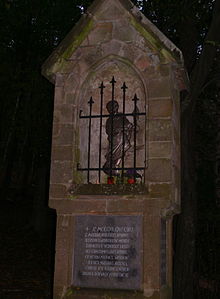Schwarzenbroich Monastery
Schwarzenbroich Monastery is a ruin in the forest between Gürzenich and Schevenhütte in the district of Düren , North Rhine-Westphalia, in the area of today's municipality of Langerwehe .
The Lords of the Cross of the Order of the Holy Cross , OSC , lived in the monastery .
location
The monastery was at the foot of the Knosterberg. Today only the heavily overgrown, up to 6 m high wall remains can be seen there. In the Middle Ages the location was called Matthiasthal because it is said that Werner von Merode the Apostle Matthias appeared here in 1340 . He asked him to build a monastery on the site. The pilgrimage route led directly past the monastery , which led from Düren via Gürzenich , Derichsweiler , Schevenhütte to the famous pilgrimage site of Kornelimünster . It is part of the Camino de Santiago and is marked accordingly with the scallop shell as a sign of the Camino de Santiago.
history
Archbishop Walram of Cologne granted permission to build the monastery on February 16, 1340, which from then on was settled by canons of the Order of the Cross . The founder provided the monastery with a large income, for example the right of patronage over the parish of Mariaweiler . In the 15th century the wealth of the monastery had increased very strongly, as the crusaders were mainly recruited from the sons of the wealthy Rhenish nobility and brought land and other assets with them when they entered the order. The monastery now also owned a number of large farms and vineyards in the area.
Therefore the monastery church could be rebuilt. It was on April 14, 1429 consecrated . The monastery was extensively renovated in the 16th century. In 1712 the monastery church was rebuilt after the destruction in the Thirty Years War . In the turmoil of the French Revolution in 1794 all the Kreuzherren had to flee to the area on the right bank of the Rhine, namely to Schönrath, today possibly Cologne-Höhenhaus . 13 Canons returned. In 1802 the monastery was dissolved by the French.
One of the most famous canons of the Schwarzenbroich Monastery was Franz Theodor Biergans , who was born in Aldenhoven in 1768 and belonged to the Schwarzenbroich Monastery from 1786 to 1794 with interruptions. He finally left the monastery after the French invaded. In the following years he entered the political stage as a German Jacobin in Cologne and criticized the church and feudal lords as a supporter of the French revolutionary ideals. From 1795 Biergans published the political magazine "Brutus or the Tyrannenfeind" in Cologne and in 1796 the magazine "Brutus der Freye" in Aachen .
The Antwerp reredos of the parish church of St. Martinus in Langerwehe is said to come from the Schwarzenbroich monastery.
On September 2, 1803, the monastery was put up for auction for an estimate of 30,950 francs. On March 1, 1804, Schwarzenbroich was bought by Gerhard Melchior Urbach from Dürwiss and Johann Georg Stoltenhoff from Eschweiler at a price of 30,500 francs. The new owners extracted vitriol salts and alum from the iron-rich peat and bog soil.
On the evening of March 24, 1835 the bells rang in the Echtz fire alarm, because the monastery building and church in Schwarzenbroich were in flames and were badly damaged. The damaged buildings were not repaired. The entire system was sold a year later to the Count (today: Prince) of Merode . After 496 years, the monastery returned to the hands of the founding family, who are still the owners today. The ruins were a popular excursion destination until World War II . During the battle in the Hürtgenwald (1944) the remaining ruins were destroyed down to the foundation walls.
Others
In addition to pastoral care in Mariaweiler, the Brothers of the Cross also worked in the hospital and infirmary in Geich near Langerwehe.
Remnants of the monastery library are scattered across various libraries.
The monastery is the scene of the historical thriller Mönchsgesang by Günter Krieger .
literature
- E. von Dorst-Gudenau (1882): The Kreuzbrüder monastery Schwarzenbroich (Mathiasthal) and the Spital zu Geich . in: Zeitschrift des Aachener Geschichtsverein , fourth volume, Aachen, 1882, pp. 1-20.
- Friedrich E. Freiherr von Mering (1849): History of castles, manors, abbeys, etc. Monasteries in the Rhineland and the provinces of Jülich, Kleve, Berg and Westphalen . Publishing house by FE Eisen, Cologne
- Paul Fabianek (2012): Consequences of secularization for the monasteries in the Rhineland - Using the example of the monasteries Schwarzenbroich and Kornelimünster . 2012, Verlag BoD, ISBN 978-3-8482-1795-3
Web links
- Franz Theodor Matthias Biergans, prominent resident of the monastery
- http://heinzstuettgen.de/onewebmedia/kloster.htm
Individual evidence
- ^ Wilhelm Heinrichs, Order and its branches in old Düren, 2003, Hahne & Schloemer-Verlag, ISBN 3-927312-55-X , page 60
- ^ Paul Fabianek: Consequences of secularization for the monasteries in the Rhineland - Using the example of the monasteries Schwarzenbroich and Kornelimünster . Verlag BoD, 2012, ISBN 978-3-8482-1795-3 , pp. 17-20
- ↑ http://archivalia.tumblr.com/post/19203576746/http-brandeisspecialcollections-blogspot-com-2008
Coordinates: 50 ° 46 ′ 22.6 " N , 6 ° 21 ′ 57.7" E


